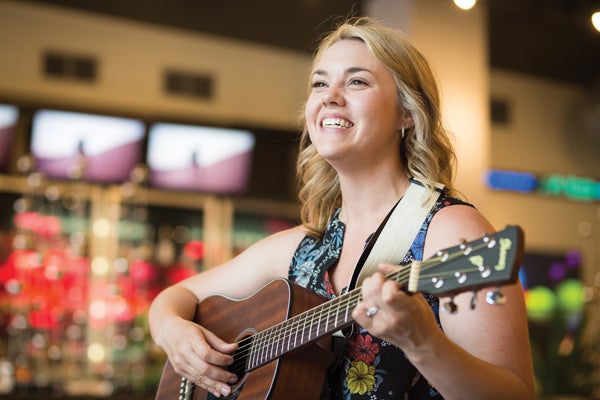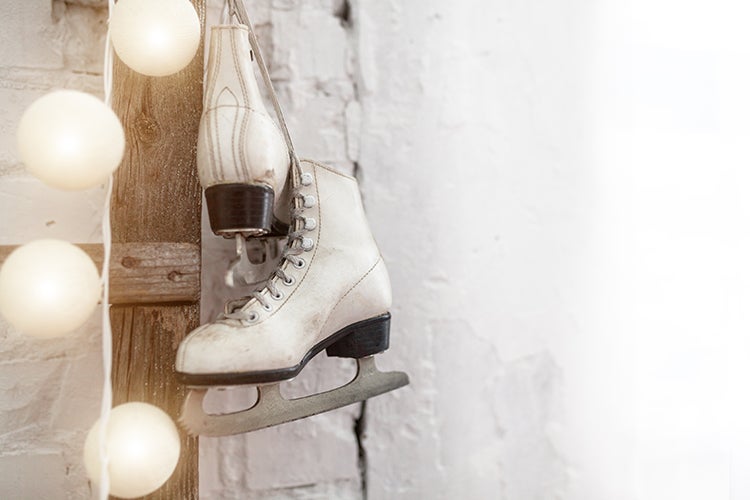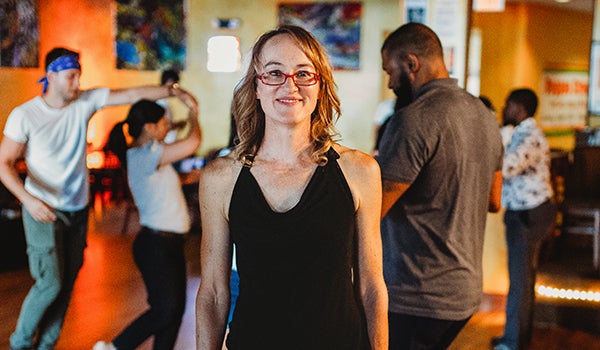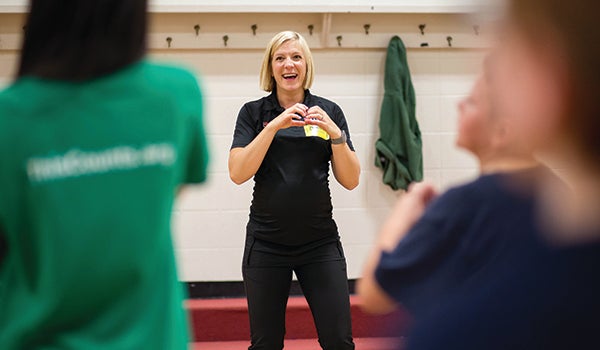Local woman changing the lives of patients with a guitar and her voice
Sitting on a chair in the corner of WXYZ Bar, Cambrae Fox strums the guitar on her knee and covers “Thrift Shop” by Macklemore. She is surrounded by her keyboard, amp, banjo and a small group of dedicated fans.
When it comes time to rap the first verse, Cambrae sings the lyrics instead. She does the same thing when she plays the Black Eyed Peas song, “Where is the Love.”
“I like to adapt songs on my own and make my own version,” Cambrae says. “Whitney Houston’s ‘I Want to Dance with Somebody’ is obviously a really fast pop song, but it’s actually super sad, so for that one I play a slow version. Or I’ll mash songs together. ‘Too Close’ by Alex Clare and ‘Say My Name’ by Destiny’s Child have the same chord progression.”
On most weekend nights, Cambrae can be found playing at a bar in the South Bend area. On Fridays, she is typically at the WXYZ Bar in the Aloft Hotel or LaSalle Kitchen Tavern, and on Saturdays, she plays at Villa Macri in Toscana Park.
 At each performance, she monitors the crowd’s mood to confirm they like what she is playing — a tapping of a foot or the swaying of shoulders, but for the most part, it is her time to play the songs she loves — the songs she wants to sing — because at her day job Monday through Thursday, it’s not up to her what she plays.
At each performance, she monitors the crowd’s mood to confirm they like what she is playing — a tapping of a foot or the swaying of shoulders, but for the most part, it is her time to play the songs she loves — the songs she wants to sing — because at her day job Monday through Thursday, it’s not up to her what she plays.
On the other hand, the songs she sings carry more weight than an acoustic rendition of a rap song. At work, her music helps to save lives.
Cambrae is a music therapist at Memorial Hospital and spends her days singing songs and teaching music lessons to children from various hospital units. For most lessons, she places colorful stickers beneath different frets on ukeleles to help her patients remember which chords to use.
Before Cambrae started at Memorial, music therapy was not a service the hospital offered.
“I sought them out,” Cambrae says. “I put together a lengthy proposal. I met with them quite a few times and was able to start and build the program.”
While at the hospital, Cambrae spends the majority of her time with children. She works in the newborn intensive care unit, pediatrics, pediatric intensive care, pediatric hematology-oncology and, on occasion, meets with women with complicated pregnancies.
She says music therapy can benefit patients in a variety of ways, and Cambrae has different goals for each person she meets. For some children, it is providing them with a source of independence or control in their lives, as most children in the hospital, especially those with cancer, have a limited amount of say in what they eat or do.
These patients’ doctors, parents and nurses make those decisions almost 24 hours a day, so having some time where they are given even a little power or authority can significantly boost their mood. When they are with Cambrae, the children get to pick the songs they learn on a ukulele or what song she sings.
In the NICU, Cambrae begins to work with infants who are as young as 28 weeks after gestation.
“I add live music when parents are doing skin-to-skin holding,” Cambrae says. “That helps increase the babies’ oxygen saturation — so how much oxygen is in their blood. It can help stabilize their heart rate. It helps increase moms’ breast milk production. I make recordings of the parents’ voices for the babies. A lot of parents cannot take two, three, four months off of work to be at the hospital every day.”
 Cambrae says she tracks health-related results from her patients rigorously, and every method she uses is backed by research.
Cambrae says she tracks health-related results from her patients rigorously, and every method she uses is backed by research.
For instance, music can also decrease a premature infant’s stress, according to “A Meta-Analysis of the Efficacy of Music Therapy for Premature Infants” by Jayne Standley, Ph.D. This meta-analysis also states that music appears to be more effective compared to unintentional ambient noises, which can actually increase an infant’s overall stress.
Another way she has demonstrated that her work can improve the health and wellbeing of a child is through lyric analysis.
“Most adolescents who have attempted suicide don’t know why,” Cambrae says. “They know they’re upset, but they can’t really communicate all that.”
The CDC recently reported that adolescent suicide rates are at an all-time high. Helping children to better communicate their emotions is one way to improve their ability to cope with and understand what they are feeling, according to an article published by Jennifer D. Jones in the Journal of Music Therapy.
When Cambrae analyzes lyrics with an adolescent, they tell her their favorite song and go over the lyrics. She says in the past, a popular song adolescents chose was “Cool Kids” by Echosmith.
“As we listen to it, I’ll go, ‘so the artist says this. What do they mean by that?’” she says. “Then the [adolescent] is able to explain it, and everyone reflects themselves in the music they like. … Then I can ask them if that’s something they feel sometimes. Then they are able to use that as a gateway without necessarily feeling vulnerable.”
Since January of this year, Cambrae has been piloting on the adult floors of the hospital. She hopes to use this as an opportunity to expand the music therapy department at Memorial by adding another therapist.
Currently, she makes up the entire department, which is completely supported by donors.
“It’s funded philanthropically through donations and fundraisers,” Cambrae says. “The Sunburst has gone to the Music Therapy department before. It’s a very difficult thing to bill because insurance will only sometimes cover it. … On top of that, I really made it a priority not to make it a billed service because I didn’t want people who could benefit from it to have to turn it down.”
The hospital agrees that music therapy should be available to all of its patients — not just those who can afford it. Still, Cambrae says that she lacks the time to serve all the patients that could benefit from music therapy, and that other hospitals the size of Memorial often have five or more music therapists.
Cambrae says that oddly enough, her work as a music therapist helps to make her a better performer and vice versa.
“When I’m on stage I can tell you what the feel is. I can tell you what’s going on — if they like a song or are paying attention,” she says. “They both play off each other. My performances improve my abilities as a music therapist because musically, some of my skills are continuing to improve.”
Photos by Mark Bugnaski





